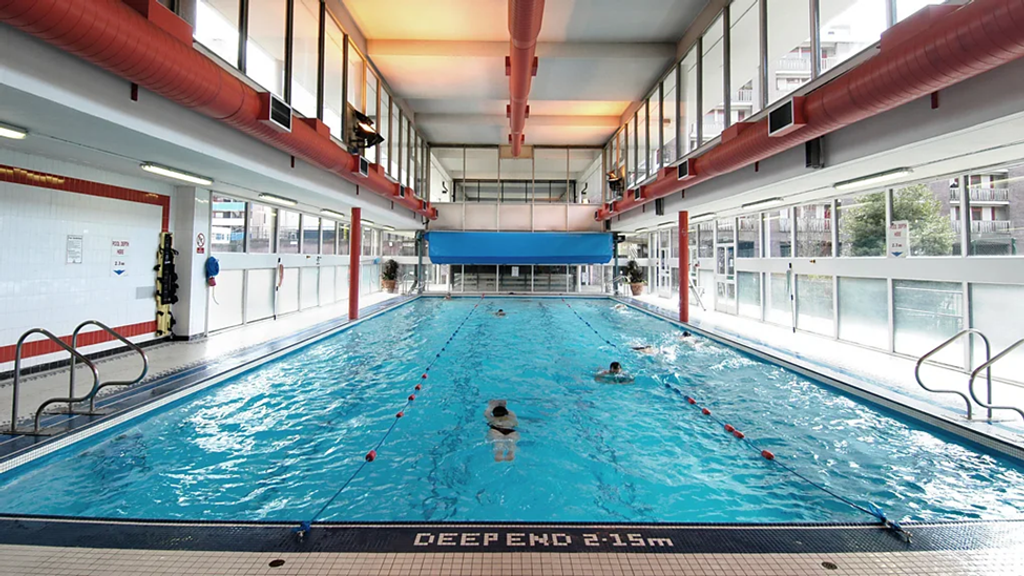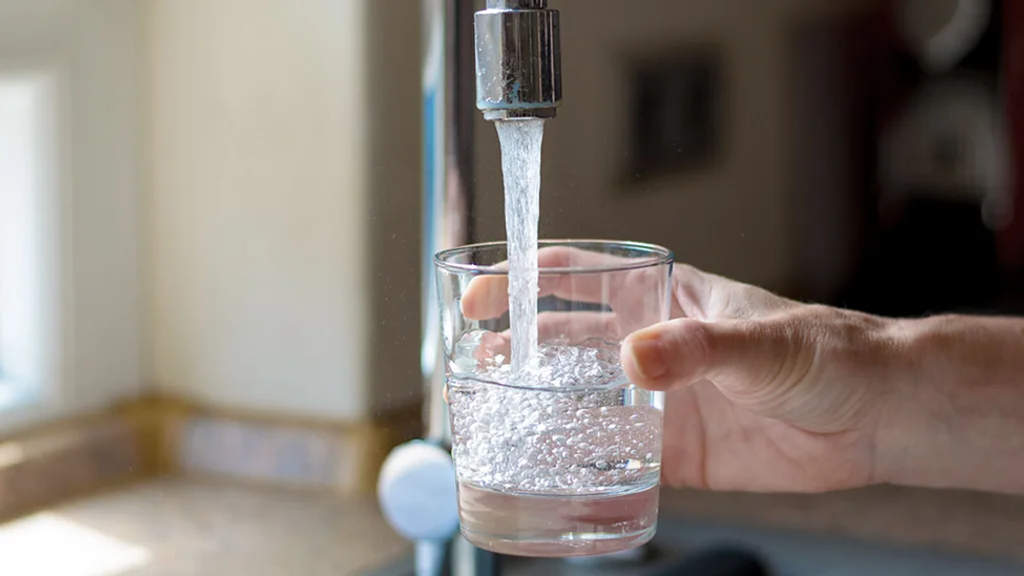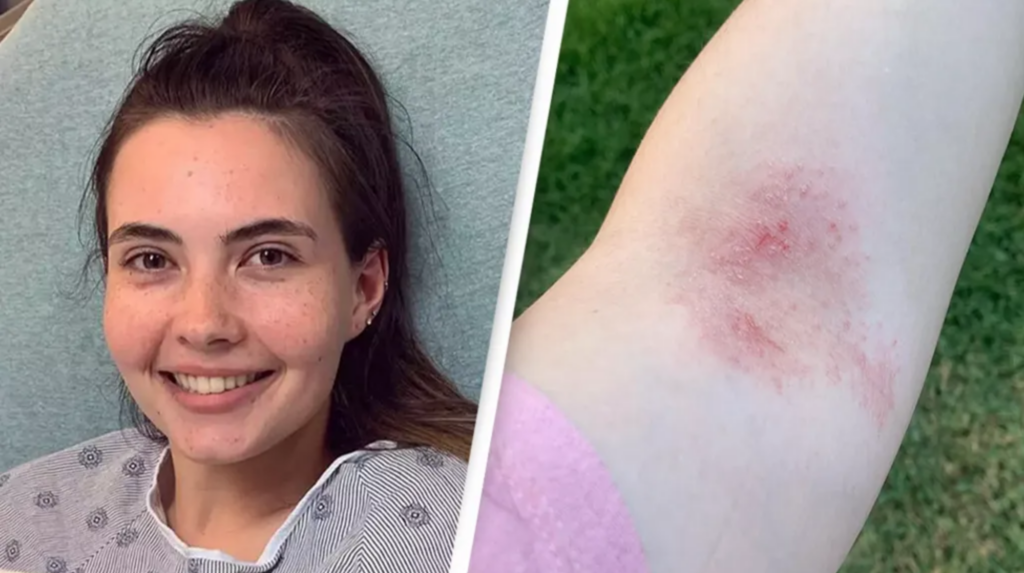When Rachel woke up, she drank something that felt like stinging nettles in a glass. It made her throat burn and left red, itchy marks on her skin. Later that day, hot drops of the same liquid started falling from the sky. Rachel saw people playing in a pool with the same stuff at the leisure center. They seemed fine, but her skin hurt when she tried to join them.
No, this isn’t a strange, otherworldly tale. This is the life of Rachel Warwick, who has an allergy to water. In her world, a simple bath becomes a nightmare, and swimming in tropical oceans is as awful as using bleach on your skin. “Those activities are my worst nightmare,” she admits.
Even the slightest touch of water, including her sweat, causes Rachel to develop a painful, swollen, and extremely itchy rash that can persist for hours. “It feels like I’ve just finished running a marathon. I get exhausted afterward, so I have to rest for quite some time,” she explains. “It’s awful, and if I cry, my face swells up.”
Aquagenic urticaria, rare condition often referred to as a ‘water allergy,’ is like experiencing the sting of nettles and the discomfort of hay fever on a daily basis.
The Challenge of Daily Life with Aquagenic Urticaria
You might be wondering how Rachel manages to live with this condition. After all, we’re often told that water is essential for life. NASA even looks for signs of water when searching for extraterrestrial life. The human body comprises about 60% water; an average 70 kg adult has around 40 liters.
Let’s clarify a few things. First, the water inside our bodies doesn’t cause the reaction. It’s triggered by skin contact, whether the water is hot, cold, pure, or salty. Even super clean, distilled water can set it off.
“When people discover my condition, they often ask the usual questions – ‘How do you eat?’ ‘How do you drink?’ ‘How do you wash?’ The truth is, you have to deal with it and carry on,” explains Rachel.

For Rachel, diving into this pool would be like swimming in potent bleach
From the start, aquagenic urticaria has puzzled scientists as much as it puzzles the rest of us. Surprisingly, it’s not technically an allergy because it’s probably triggered by the body’s immune response to something inside the body rather than an exaggerated reaction to an external substance like pollen or peanuts.
The earliest idea to explain its mechanism suggests that water interacts with the outer layer of skin, which is mostly made of dead skin cells or the oily substance that keeps skin moist. This contact with water might cause these components to release harmful compounds, prompting an immune response.
Some have proposed that water might dissolve chemicals in the layer of dead skin, enabling them to penetrate deeper and trigger an immune response.
Applying chemical solvents to the skin before exposure, which allows more water into this layer, worsens the reaction. However, even when the top layer of skin is completely removed, the reaction still occurs.
Another unconventional theory suggests that pressure changes may inadvertently trigger the immune response as water leaves the skin through osmosis.
Scientific Insights and Treatment Trials
Regardless of the reasons behind it, according to Marcus Maurer, a dermatologist who established the European Centre for Allergy Research Foundation (ECARF) in Germany, this condition is extremely debilitating and can significantly alter lives. “I’ve treated patients who have suffered from urticaria for 40 years and still wake up with rashes and swelling every day,” he explains.
Those affected may experience depression or anxiety, constantly worrying about when the next attack will occur. “In terms of how much it affects quality of life, it’s one of the most severe skin conditions you can have,” he adds.
After noticing a rash following swimming, Rachel was diagnosed when she was about 12 years old. “My doctor listened to my symptoms and said, ‘I think you have this.’ I was lucky that he was familiar with it,” she recalls.
She wasn’t referred for testing. The usual way to diagnose the condition is to keep the upper body wet for thirty minutes and observe the reaction. “He said the testing process would be more unpleasant than the illness itself,” she explains.
While living with the condition itself isn’t impossible, coping with daily life presents challenges. For instance, during heavy rainfall in winter, Rachel cannot leave her home.
Rachel’s husband, also her official caregiver, takes over tasks like washing dishes. She limits herself to showering just once a week. To reduce sweating, she wears lightweight clothing and avoids strenuous exercise. Like others with the condition, Rachel consumes much milk since it doesn’t trigger as severe a reaction as water does. Once again, the reason for this remains unknown.

People with an allergy can’t even tolerate rain or snow on their skin
Finding a cure for this mysterious illness has been quite confusing. Currently, the usual treatment involves taking strong antihistamine medications. To understand why, let’s first grasp what happens during a reaction.
The sequence of events begins with activating immune cells in the skin, specifically mast cells. These cells initiate a series of reactions by releasing a crucial component: histamines. Histamines, typically beneficial in immune responses, facilitate the leakage of blood vessels, enabling white blood cells to enter and combat intruders. However, in the context of an allergic reaction, the result is the unwelcome effects: fluid seeping out through the vessel walls, leading to localized skin swelling.
At the same time, histamine triggers “itch neurons,” whose sole purpose is to make us feel itchy. This leads to the formation of raised, itchy areas of skin known as welts.
In theory, antihistamines should be effective every time. However, in reality, the results of these drugs are often mixed.
In 2014, Rachel participated in a documentary and was sent to the ECARF in Berlin, where doctors suggested she try a high dosage of antihistamines. She followed their advice and tested them out at her local swimming pool. Unfortunately, it didn’t work. “Afterward, I was itching like crazy and looked like I had a disease,” she recalls.
For years, the only choice for treatment was antihistamines. Then, in 2008, Maurer and his colleagues at the ECARF came up with an idea. “We didn’t evolve mast cells to cause urticaria. So, what triggers them to misbehave?” he questions.
In individuals with the condition, the cells that release histamine appear normal and are not more abundant than in others. So, something else must be provoking them. Based on lab studies, scientists suspected that the culprit might be IgE, the antibody responsible for typical allergies like those to pollen or cats.
“Instead of reacting to external factors, they’re producing IgE in response to something within themselves,” explains Maurer.
All they needed was a drug that could block the effects of IgE. Fortunately, a drug was already available on the market capable of doing just that.

A drink of water scorches Rachel’s mouth
Omalizumab was initially developed as an asthma treatment. “When we proposed using this anti-allergic drug for these patients, the drug company questioned us, asking why we would want to do that. They argued it’s not an allergy, so how could it work?” recounts Maurer.
After persuading the skeptics, they tested the idea in August 2009. Their patient was a 48-year-old woman with another rare form of urticaria triggered by pressure. For three years, she had been experiencing a raised, itchy rash at the slightest touch, even when combing her hair or getting dressed.
Remarkably, after just one week of treatment, the woman’s symptoms visibly improved. By the end of the month, they had completely disappeared.
Since then, scientists have found that omalizumab works against even the rarest forms of urticaria, such as reactions to sunlight, temperature changes, or friction. “It’s incredible; this drug changes everything,” says Maurer.
One of Maurer’s initial patients was a young professor who reacted to his sweat. He couldn’t even catch the bus without getting a painful rash, and he couldn’t lecture his students because even a little sweat would disfigure him. “He was almost ready to give up his academic career,” says Maurer. But after just a week on omalizumab, he was like a new person.
It’s safe and effective—it even works for aquagenic urticaria. This sounds like a happy ending. But there’s a problem. The asthma drug is currently used “off-label,” meaning its effectiveness against urticaria hasn’t been proven in a large clinical trial. Most healthcare providers, including insurance companies and the UK’s NHS, won’t cover the cost of drugs without such proof.
Navigating Treatment Barriers
This was the issue Rachel faced in 2014 when the specialist in Berlin suggested omalizumab. Currently, the drug would cost her about a thousand euros per month.
Finding enough patients for a trial could be tough. Aquagenic urticaria affects roughly 1 in every 230 million people, meaning only about 32 individuals worldwide. “We see over 2,000 new urticaria patients each year, and only three have aquagenic urticaria,” says Maurer.
Adding to the challenge, the drug’s patent is expiring soon. With little time left to profit from it and only a handful of potential customers, persuading the company to fund a trial would be very hard. “I’m not sure we’ll see such a trial,” Maurer admits. Novartis, the company that sells the drug as Xolair for asthma and other conditions, confirms they have no plans to explore its use for aquagenic urticaria. “We believe that using drugs without a license should be limited to cases where there’s a genuine medical need that licensed medications can’t meet, or as allowed by regulations designed to protect patient safety,” their spokesperson explains. After decades of research to solve this mysterious disease, the final challenge isn’t scientific but economic.
So, what’s the first thing Rachel would do if she found an effective treatment? That’s easy. “I’d love to be able to go swimming at the leisure center. And dance in the rain,” she says.
Advisory Note: This site is primarily intended for healthcare professionals. Any content/information on this website does not replace the advice of medical and/or health professionals and should not be construed as medical/diagnostic advice/ endorsement or prescription.
References
The woman who is allergic to water [Internet]. Accessed on May 15, 2024. Available at: https://www.bbc.com/future/article/20160915-the-woman-who-is-allergic-to-water
About Docquity
If you need more confidence and insights to boost careers in healthcare, expanding the network to other healthcare professionals to practice peer-to-peer learning might be the answer. One way to do it is by joining a social platform for healthcare professionals, such as Docquity.
Docquity is an AI-based state-of-the-art private & secure continual learning network of verified doctors, bringing you real-time knowledge from thousands of doctors worldwide. Today, Docquity has over 400,000 doctors spread across six countries in Asia. Meet experts and trusted peers across Asia where you can safely discuss clinical cases, get up-to-date insights from webinars and research journals, and earn CME/CPD credits through certified courses from Docquity Academy. All with the ease of a mobile app available on Android & iOS platforms!







